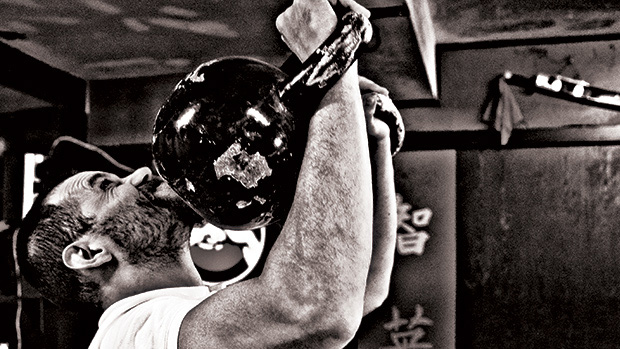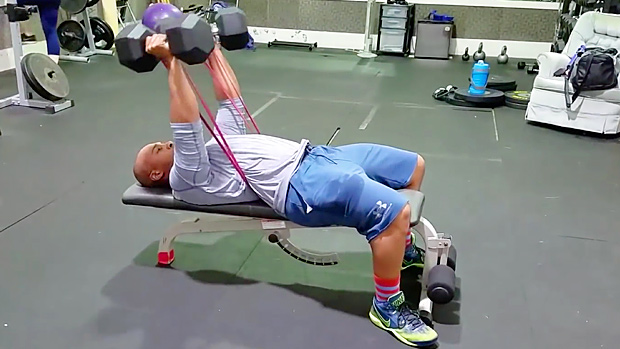The Question
There are a lot of things in training and nutrition that are generally considered bad or incorrect. What "wrong" thing works great for you?
Michael Warren – Strength Coach and Performance Expert
I like training the same body part twice a day. This is not recommended in personal training curricula.
When it comes to training, the general belief is that you need to give the muscle enough time between workouts to rebuild, and many say you can't train the same muscle within a 48-hour period.
I started doing this 6-7 years ago out of necessity. I had a pretty hectic schedule with clients, and simply didn't have enough time to complete a full session. But what I did have was two small opportunities most days with an open window in the morning and then another one in the evening. This allowed me two, 45 minute sessions a day.
I experimented with different training methods and made progress with this one in both how I felt during the workouts and the results I achieved, which were noticeable. What I found was that by only training for 30-45 minutes it allowed the session to be focused and intense. The break gave me the chance to recharge and refocus prior to the second workout.
My beliefs about it were reinforced when Charles Poliquin advocated training the same body part twice in one day. By training this way, it increases the overall volume than most would complete in one session, which is huge in gaining size. But also I've found that the quality of work is superior.
Here are some guidelines for training like this:
- Hit the same muscle group in both the morning and evening workout.
- Change the training protocol from the AM to PM session. In the morning session do fewer reps (6-8). In the evening session, lighten the load and do more reps (12-20). The second workout consists of more classic bodybuilding strategies: slow tempos, iso-holds, negatives, drop sets, etc. Vary the exercises and stimulus from morning session to evening session.
- Recover as much as possible. Give yourself 6-8 hours between sessions, and meet your nutritional requirements between workouts.
- This is not a method you should do forever. You'll need to take breaks and return to once-a-day training every 2-4 weeks.
Granted, this might not be feasible for you, but it's a method that can be a temporary 2-4 week block to overcome plateaus and stimulate more growth. – Michael Warren
Eric Bach – Strength Coach and Performance Expert
I prefer faster fat loss approaches, but the "rules" say to take it slowly.
Conventional wisdom says you should lose body fat slowly to build sustainable long-term habits, prevent metabolic adaptation, and fight muscle loss. But I think aggressive, 30-45 day fat loss phases are better than the long, slow, and steady approach. Here's why:
- You lose momentum: Staying in a caloric deficit is an additional stressor to an already stressed-out society. This leads most people to fall off the wagon and get stuck in the endless cycle of yo-yo diets and quick fixes followed by binges, guilt, and quitting. You can't discount momentum and the human element when it comes to fat loss. Go hard for a limited period of time, then get back to a sustainable maintenance or lean bulk phase.
- Every day that you're dieting, you're not building muscle. It takes much longer to build appreciable amounts of muscle mass than it does to lose fat. And if you're constantly dieting down because you "can't find a diet that sticks," you'll get stuck in the purgatory of yo-yo dieting.
Focus on fat loss and go all in. Yes, it'll be brutal and you'll get hungry. Suck it up, then get back to the muscle-building process. Not only will it be easier to build muscle without fat, but in the long-term more lean muscle will provide a "dietary" buffer due to an increase in resting metabolic rate and an increased ability to store food as muscle glycogen.
So, how can you set up an aggressive fat loss diet? First, continue to train as heavy as you would when building strength. The primary driver of fat loss is diet, but you can add an extra conditioning workout or two, or start walking each morning for a small boost in fat loss.
For your diet, research has shown a caloric deficit as big as 20-25% to be enough to maximize fat loss without serious detriments to performance and lean muscle. Keep your protein at or above 1 gram per pound of bodyweight to maintain lean muscle mass, and dietary fat above 20% of total calories to keep hormone levels from jumping around too much.
Here's an example of what this could look like for a 200 pound man:
- Maintenance calories: Bodyweight (pounds) x 14 = 2800 calories
- Aggressive deficit: 2800 x .75 = 2100 calories
- Protein: 200 grams (800 calories)
- Carbohydrate: 200 grams (800 calories)
- To find grams of fat: 2100 - 800 - 800 = 500 calories. So, 55 grams of fat
So, a 200-pound man would eat approximately 200 grams of protein, 200 grams of carbs, and 55 grams of fat each day. Focus on hitting your calories first, protein second, then eat carbs and fats based on your preferred eating style. With this approach, you have an aggressive plan to lose fat, a short-term plan to maintain momentum, and the end in sight to help you stay consistent. – Eric Bach

Aaron Fick – Strength Coach
I never plan or take "deload" weeks. You know, where you're supposed to train light or back off for a week.
Deload weeks are wasted training weeks. If you're getting stronger, training is going well, and you're making gains every week, why deliberately halt the progress?
Inversely, if you're trashing your body so hard every week that you need to take a deload week, you probably need to back off and stop killing your body three weeks out of the month.
Telling yourself that you're going to deliberately back off the weights and take it easy is a poisonous mindset. It's an excuse to do half-ass training.
Instead of taking a deload week, start incorporating variations of the main lifts that are, by nature, pound for pound lighter. Try front squats, beltless squats, or pause squats instead of the back squat. Or do close-grip bench, pause bench, or incline bench instead of the flat bench press. Give power cleans a shot instead of deadlifts. Doing this ensures the quality effort is there, but the ultra heavy poundage isn't always there to fry the nervous system or the rest of the body.
If you're sick of the weights and plan to half-ass train, don't even go to the gym. Go out for a hike, get some fresh air, take a breather outside of the gym. This will prevent burnout. – Aaron Fick
Christian Thibaudeau – Strength Coach and Performance Expert
I like doing explosive work after strength and/or bodybuilding work, which you're not "supposed" to do.
One of the first things we learn in kinesiology classes about program design is that exercises with the highest neurological demands should go early or first in a workout when the nervous system is fresh. Doing them then also potentiates the rest of the session.
And I agree. But doing the explosive work afterwards has given me, and several athletes I work with, great results. It sounds completely illogical but it works, especially in individuals who are already naturally explosive. Why? I have two explanations (and it's likely a combination of both):
- When you do a basic strength movement (like bench press and squat) with a moderate weight, and you lift it for maximum acceleration, you must decelerate before you reach the end of the range of motion, otherwise you'll put a lot of stress on your joints.
And the more acceleration you can produce from the start, the sooner you must decelerate. It's like if you're driving a car and you see a wall 100 meters away. If you're driving 20 mph you won't be stressed; you can take your time and brake at the last minute. But if you're going 120 mph you'll need to brake a lot sooner. Same thing with lifting.
When your muscles have been fatigued prior to explosive work you can't produce as much initial acceleration, as such you can accelerate for longer. This drills your nervous system to be capable of accelerating at points in the range of motion where it would normally decelerate. Note that speed work against bands has a similar effect: they allow you to keep trying to accelerate because the bands brake/slow you.
- Doing explosive work primarily focuses on the fast twitch fibers. When they're fatigued you'd normally have a hard time stimulating them, relying more on intermediate fibers. Doing explosive work at that time might force your body to keep using the fast twitch fibers, putting a little bit more fatigue on them.
I use a similar strategy with CrossFit athletes. I have them do their snatch or clean & jerk after their squats and deadlifts. They'll do two phases and the last phase they switch the order. All have had serious gains in their lifts. One went from a 245 pound snatch to a 295 pound snatch, and from a 315 pound clean to a 375 pound clean. Of course that's an extreme example, but all reported solid gains from an illogical approach. – Christian Thibaudeau
Tom MacCormick – Personal Trainer and Online Coach
Training in an unbalanced or non-symmetrical fashion works great for me.
You often hear that you have to balance the ratio of pushing to pulling and upper body to lower body to achieve a balanced physique. I disagree. This advice is good for a beginner, but not for intermediate/advanced lifters.
When you begin training, everything is small and weak. In that case, working everything evenly is a good option. As you become bigger and stronger, however, certain muscles will respond better to training and others will lag behind. If you continue to train in a balanced fashion you'll exaggerate the issue.
Certain muscles, which dominate particular movements, will continue to overpower others and magnify your imbalances. For instance, your anterior delts and triceps might minimize chest stimulation on the bench press. The problem becomes a self-perpetuating cycle and your physique will become increasingly disproportionate.
Once you reach a decent level of muscularity, to achieve symmetry you actually need to train asymmetrically. For example, my biceps and shoulders don't grow well from just being trained with chest and back. Instead, I train them more frequently, which allows for greater overall volume. While chest and back get hit twice per week, I target my rear delts, lateral delts, and biceps four times a week.
Following this approach has paid massive dividends and allowed my shoulders and arms to catch up to my chest and back. – Tom MacCormick
Mark Dugdale – IFBB Pro Bodybuilder
I do three "wrong" things.
These are the first two: I don't really do any cardio, but I do hot yoga. You wouldn't typically associate either with a guy prepping to compete in a pro-bodybuilding contest, right? And if you're a competitor, neither one would likely be in your coach's competition prep program.
The larger "wrong" thing I like to do, however, is take calories below 1,700 per day in the final push to being absolutely ripped. Most people would say it's far too catabolic, but properly timing those calories makes a world of difference. And the bulk of my nutrition comes around the training window, so muscle is supported. Getting my calories low contributes to why I don't do cardio. Getting ripped via diet tends to help muscle retention better than doing it through cardio from personal experience.
Yes, an ultra-low caloric intake for months on end is a recipe for muscle loss, but when your body is primed for fat burning, and you cut your nutritional fat sources, then your body's able to tap into the stored fat that obscures your muscle.
I eat a lot of almonds while dieting, and in the last few weeks I cut them out completely. My body looks for the nutritional fat source and doesn't find it. The result is I suffer, and my body burns off the last bit of fat that few competitors tap into. The end result is a nasty, ripped physique. – Mark Dugdale
Paul Carter – Strength and Bodybuilding Coach
I often use extremely low volume, high intensity training.
The reason this is "wrong" is because of the research that seems to point to volume as the single most important factor when it comes to muscle growth.
By the time I was 18 years old I was already 220 pounds (and yes, all natty bro) from 98 pounds, and I had only started training four years earlier. If you had to ask me what my training looked like back then, it was very bro-science-anti-science: 1-2 working sets for a movement, training four days a week, and hitting each muscle directly once a week.
My focus was on progressive overload, adding more reps to a particular weight each week. I had an incredibly simple method when it came to rep selection and goal setting: Pick a weight you can hit for 8 reps, stay with it until you can get 12. Once you can get 12, up the weight.
That was it. Every week I'd push hard on those one or two working sets (if there was a second set I'd reduce weight by 10-15% and go to failure) and do my best to beat my previous week.
If you keep up with the research, it'll tell you that I was training inefficiently compared to training body parts twice a week (which I've done) and using a lot more volume (which I've done). However, through trial and error I kept coming back to that kind of training, because it's worked. Eventually I realized that effort, more often than not, trumps doing a whole bunch of work half-assed. – Paul Carter
Chris Colucci – T Nation Forum Director
I eat two meals a day.
One long-standing nutrition principle says to eat small meals every 2-3 hours to "stoke the metabolic furnace," maintain steady insulin levels, and manage hunger, especially when cutting calories. Only problem is that those aren't all valid points, they aren't benefits exclusive to multiple feedings, and more importantly, eating something every 120 minutes isn't practical.
While some people have used frequent feedings to build muscle and drop fat, it's not absolutely mandatory and you're not compromising any results by sticking with a more basic approach of having fewer meals per day. Any trainer worth their salt will tell you that the most perfectly designed workout or diet is totally useless if the client won't actually follow it. For non-competitive lifters who hit the gym 5 or 6 hours a week, setting aside 5 or 6 cumulative hours per day to deal with frequent feedings is impractical at best and, literally, a waste of time at worst.
Try this next time you're at work: Set your phone alarm to go off every two-and-a-half hours and when the alarm sounds, immediately stop whatever you're doing, close your eyes and recite the alphabet (silently, so you don't seem like a mental patient), then get back to work.
Odds are those 30-second interruptions will get real old, real fast. Especially if you're in the middle of a detail-oriented project, on a work call, in a meeting, or doing any number of things that should be getting your full attention. That's a small taste, no pun intended, of how obtrusive and unnecessary the "small, multiple feeding" approach is.
Instead, I've been sticking with breakfast in the late morning – most often whole eggs, fruit, vegetables, and rice/potato/toast/bagel – and then dinner in the early evening – always meat, vegetable, and carby thing. I also have Plazma™ before and during workouts, which happens to fall within my "eating window" since I train a few hours before dinner.
The plan's not "intermittent fasting," unless you're using an overly generous definition of the word "intermittent," but it does allow me to go through the day without spending mental or physical energy watching the clock, grabbing food, interrupting the flow of work to eat, and treating food like a repetitive item on a lengthy to-do list.
The only real asterisk to this approach is that I do have a serving of Mag-10® right before bed every night, a few hours after dinner, to get a pulse of aminos and kick-start the overnight recovery/growth process. So, if we're counting the 127-calorie protein drink as a standalone meal, then technically I'm up to three meals a day... which is still what successful lifters did for over a century without trouble. Chris Colucci




